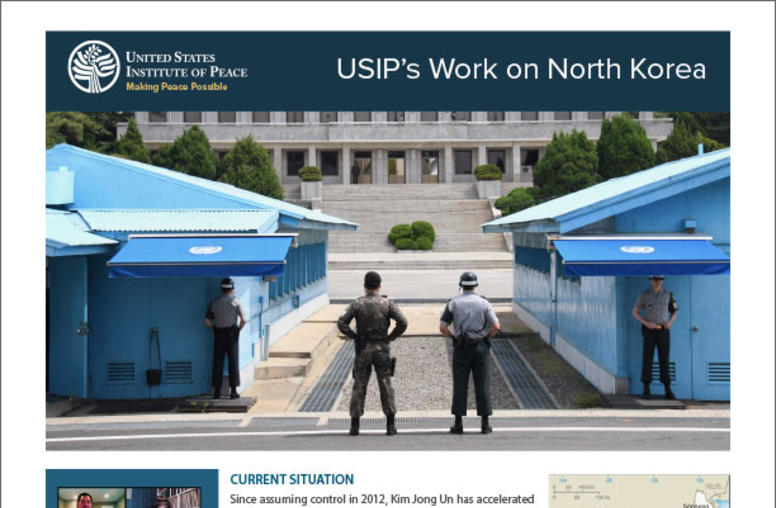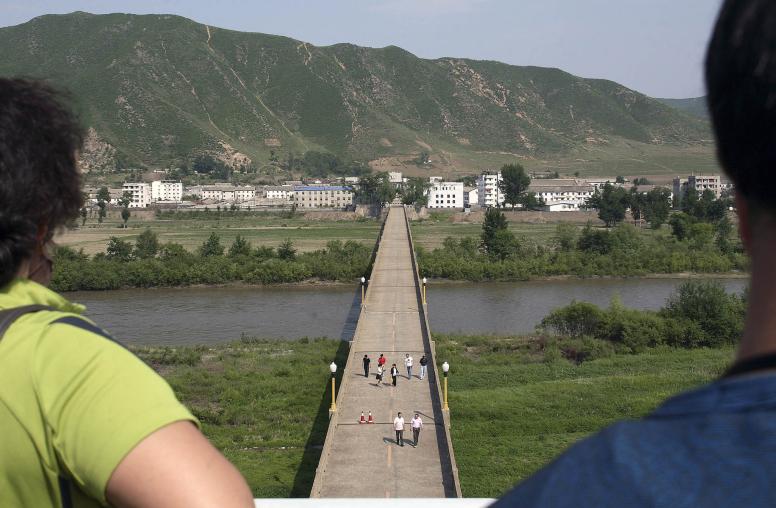A Coming Crisis on the Korean Peninsula? The Food Crisis, Economic Decline, and Political Considerations
Over the past two years there has been a remarkable transition in perceptions among Washington-based policy makers regarding the nature of the threat posed on the Korean Peninsula, from a focus on North Korea's nuclear program and military strength to a focus on the potential instability arising from North Korea's economic vulnerabilities and political uncertainties. The major challenge for the United States is to pursue its strategic objectives in Northeast Asia by dealing with the prospects of sudden instability on the Korean Peninsula.

Key Points
- Over the past two years there has been a remarkable transition in perceptions among Washington-based policy makers regarding the nature of the threat posed on the Korean Peninsula, from a focus on North Korea's nuclear program and military strength to a focus on the potential instability arising from North Korea's economic vulnerabilities and political uncertainties.
- The Geneva Agreed Framework has provided the basis for defusing potential confrontation associated with the North Korean nuclear program, but--as the North Korean spy submarine incident demonstrates--fundamental issues relating to security on the Korean Peninsula remain unresolved, and there is no well-established multilateral mechanism for dealing with issues of economic crisis and political instability. U.S.-North Korean talks and North-South contacts are sporadic and not well institutionalized. After some initial difficulties, North Korea has apparently lived up to its nuclear-related responsibilities under the Agreed Framework, including maintaining an International Atomic Energy Agency-monitored freeze on its nuclear facilities and cooperating to stabilize and containerize spent fuel from its 5-megawatt experimental reactor. However, without a confidence-building process that addresses the fundamental sources of tension on the Korean Peninsula--including the necessity of improved North-South relations--the core elements of the Geneva Agreed Framework will remain vulnerable to disruption.
- KEDO (Korean Economic Development Organization)--an international organization of American, South Korean, and Japanese staff founded to implement the Agreed Framework--has established itself as an effective interlocutor with North Korea on nuclear-related issues. KEDO has reached agreement with North Korea on the scope of its supply obligations and has provided North Korea with heavy oil as stipulated under the Geneva Agreed Framework. KEDO has also provided opportunities for indirect contact between North and South Korean government officials in the absence of other regular channels for dialogue. The major challenge to KEDO at the moment is whether sufficient political support exists in the United States, Japan, and South Korea to raise the funding and number of members from governments to ensure KEDO's financial ability to provide the required heavy oil shipments and initiate light water reactor construction. South Korean attitudes toward KEDO have moved from skepticism to cautious support of KEDO as a useful and even desirable element in dealings with the North. But as South Korean reactions to the recent submarine incursion demonstrate, in the absence of fundamental confidence-building processes on the peninsula, prospects are not bright for productive direct dealings between Seoul and Pyongyang.
- The need for continuous policy coordination among the U.S., South Korean, Chinese and Japanese governments to determine fundamental policy objectives and tactics in stabilizing relations with the North remains a significant challenge in managing the Korea issue. Although all sides share the goal of achieving a transition to peace on the Korean Peninsula, there is no consensus either within or among these countries on how to achieve this goal. Sporadic North Korean attempts to induce a crisis atmosphere on the peninsula, either to spite the South or as a tactic to maximize its negotiating advantage, underscore the critical need for a unified policy response from Washington, Seoul, and Tokyo.
- The importance of the People's Republic of China (PRC) as one of South Korea's major trading partners, an emerging political dialogue between Beijing and Seoul, and China's recent decision to resume significant levels of bilateral aid to North Korea all indicate that the PRC's influence on developments on the Korean Peninsula is growing. China is working to balance its political and economic relations with both North and South Korea in ways that will increase its influence over the shape of any final settlement between the two Koreas.
- The North's economic decline, its food crisis, and its inability to formally confirm Kim Jong Il's succession to leadership following the death of Kim Il Sung have stimulated questions among outside observers about the future of the regime. Although sudden political change in North Korea cannot be ruled out, it is by no means inevitable. Nonetheless, prudence requires preparedness for the possibility of a sudden, crisis-induced change on the Korean Peninsula; indeed, this possibility underscores the importance of seeking ways to manage a transition from confrontation to peaceful stabilization through a process of tension reduction, confidence building and maintaining security on the Korean Peninsula.
- A continuing challenge for policy makers is the food crisis in North Korea, which stems not only from successive years of flooding, but also from long-term structural failures in North Korea's agricultural system. With predictions from UN World Food Programme (UNWFP) representatives on the ground that conditions of "malnutrition" could turn into a "famine" in localized areas in the coming months, the situation is sufficiently serious to warrant an immediate humanitarian response--with full recognition that a destabilized North Korean society would hold serious security consequences for all concerned with the future of the peninsula. Emergency aid from the UNWFP and bilateral food assistance from the PRC, however, cannot resolve the structural problems in North Korea's agricultural sector, which remain unaddressed. Whether and how to give aid to North Korea to address its structural agricultural production deficit is a sensitive political issue that will require careful consideration and, if possible, coordination among South Korea, Japan, China, the United States, and international organizations, including the UNWFP.
One possible approach is to view North Korea's food situation as a symptom of core economic problems and its concurrent lack of credit in international markets. Instead of providing aid simply to satisfy North Korea's food deficit, efforts must be made to stimulate North Korea to undertake the fundamental economic and related reforms that will address the fundamental underlying structural weakness of its economy. Such reforms should enable North Korea, in time, to meet its food needs and create a political and economic environment that would attract foreign investment. For instance, South Korea, Japan, and the United States might form an international organization similar to KEDO to address structural economic needs beyond those caused by the recent flooding. Such an organization might provide credits that would allow purchases of designated items on the international market in proportion with North Korean steps toward economic transparency and agricultural reforms, rather than linking North Korea's economic problems with the separate question of political issues between the two Koreas. - Although an anticipated food crisis prior to this year's fall harvest seems to have been averted for the moment as a result of Chinese and other emergency assistance, countries directly concerned with stability on the peninsula need to develop a long-term policy for managing the complex challenges posed by the fundamental political, military and economic uncertainties in North Korea. Otherwise, a crisis might develop too quickly for a coordinated response from South Korea, Japan, and the United States. South Korea and the United States should maintain a consistent, unified approach toward the North as part of a clearly articulated strategy designed to maintain deterrence, reduce military confrontation, and achieve peaceful reunification, or, alternatively, to manage a counterstrategy that responds to a possible lack of North Korean cooperation or other contingencies.
- The food and energy crises have raised critical questions about the need for contingency planning to prepare for any sudden changes that might occur in North Korea in the absence of reforms. Likewise, advance preparations are critical for refugee flows that might result from further economic decline and/or widespread famine in North Korea. The political-military implications of instability in the North could pose unique challenges for the U.S.-South Korean security alliance and require advance coordination to avoid major differences between allies at a point of crisis.
- The major challenge for the United States is to pursue its strategic objectives in Northeast Asia by dealing with the prospects of sudden instability on the Korean Peninsula. As the only outside power with a military presence on the peninsula, the United States has a special responsibility to manage a policy coordination process with its allies at the highest levels, the objective of which should be to bring together South and North Korea to facilitate real progress in negotiating tension-reduction measures and the establishing of a stable peace on the Korean Peninsula. If attempts to initiate a North-South dialogue fail because of lack of cooperation or as a result of heightened political tensions, it may become necessary to respond to negative contingencies, in which case policy coordination will be essential. The challenge of coordinating policy toward North Korea--in the event of either a positive or a negative response from the North--will require sustained and constant attention to complex issues, many of which must be decided through consultations at the highest levels.



